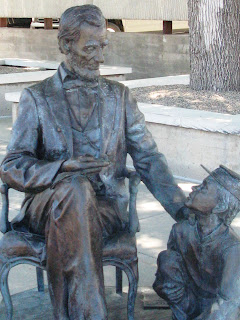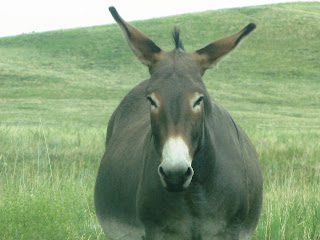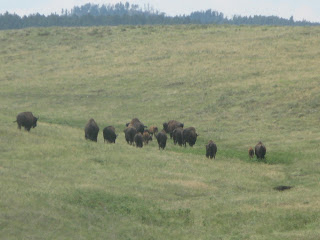More on our visit but have one last blog while we were in Rapid City.
I have to give Rapid City credit for their creativity and charm. They have some unique things to see.
To honor all past presidents, the city has commissioned several artist to sculpt life-size figures of all of the past 42 presidents. Pres. Obama will be added after his term has ended, but they already have a spot assigned.
They grace the corners of a 2 by 5 block section of the downtown area. The project began in 2000 after businessman Don Perdue relocated his company to Rapid City and noticed the interest around the life-size seated Lincoln outside of the Hotel Alex. The statue was sculpted by Gutzum Borglum, the sculptor who created Mount Rushmore. He saw how the general public interacted with this statue, often having photos taken while sitting on the bench next to Pres. Lincoln. Mr. Perdue recognized this as an asset to the city's economy, what if statues stood on every street corner?
Each sculptor did extensive research on each president to give insight into the unique personalities of each.
Veteran's have been seen placing flowers and messages on D-Day at Pres. Eisenhower's' statue and on the day Ronald Reagan died there were many who gathered at his statue placing balloons, flags, flowers and jelly beans. During the cold winter months there are knit scarves wrapped around the necks of some of the presidents.
A historic building houses the Presidents Information Center, where you can get a walking tour pamphlet of the City of Presidents, view the interior design based on the Oval Office and a replica of the Presidential Seal.
Abraham Lincoln with his son Tad. He is holding a telegram from the front lines which informs him of the great numbers of casualties at the battle of Cold Harbor.
Andrew Jackson, depicted here as a man of defiance, a characteristic that dominated his lifestyle. With military uniform billowing and arms folded sternly, the true attitude of the man.
George H.W. Bush is portrayed with a global signifying his extensive involvement in the international arena during his term. This sculpture is standing across the street from President John Adams. They are the only two presidents to have sons who also served as president.
Lyndon B. Johnson. This statue depicts Johnson in a pose that became known as "the Johnson treatment". A man of tall stature, he had a very menacing, strong presence and was know for his tendency to get "in one's face" to make a point. He is shown here with that forward thrust of his body. The books on the desk next to him are Machiavelli's The Prince and The Great Society. Engraved on the back of the desk is a map of Vietnam, a reference to the powder keg upon which he sat during his presidency.
Dwight D. Eisenhower. Viewed as one of our most historically important generals. Many veterans have been seen paying tribute at this statue. I didn't capture it in my picture, but he is standing with one foot on England, straddling the English Channel and the other foot on Europe, depicting a time in the history of the free world.
Harry S. Truman. This pose is one of the most famous. Shown displaying the morning Chicago Daily Tribune newspaper the day after the presidential election of 1948. The big smile due to the erroneous headline declaring his opponent as the winner.
F.D. Roosevelt. The sculptor, chose to depict President Roosevelt as he stood during a presentation to the nation during a time when he was suffering from the effects of polio. The statue shows just a hint of the leg braces he wore. It shows him gripping the podium to steady himself and his determination to project the image of the strength and the will of the man despite his physical restraints. He is shown delivering his famous "day which will live in infamy" speech.
Richard M. Nixon. This statue him during delicate negotiations for the opening of China to the western world. He is posed in a Chinese-design chair, while negotiating with Mao-Tse-tung.
John F. Kennedy with his son John Jr. He is handing his son one of John-John's favorite toys, an air fighter plane.
Martin Van Buren. Seated on a bench, reading his local newspaper, the Kinderhook. He was also called "Old Kinderhook" from which we get our saying "OK", as he was perceived as usually being correct.
William H. Taft was the first President to throw out the opening pitch of the major league season, and is shown here in his pitchers stance. Behind his back he is holding a baseball. He was drafted to play professional baseball but chose to attend Yale Law School instead.
Ok enough of the presidents, but if your ever near Rapid City, take a walking tour of The City of Presidents, you won't be disappointed.
The city's newest area is Main Street Square, a public space that features interactive fountains. Special events, arts and culture, live concerts and even ice skating in the winter take place in this area.
Art Alley or Painters Alley, is an outdoor art gallery lining one full city block alley with murals and graffiti of local artist. The entire block features graffiti murals on trash cans, fire escapes and utility meters, offering reminders of MLK's speeches, suffering that has happened in our country and our
desires for peace and love.
The last attraction we found interesting in Rapid City was The Berlin Wall memorial.
Free of charge, open to the public, located in Rapid City's Memorial Park features two 12 ft segments of the original Berlin Wall, some WWII tank traps, accompanied by interpretative placards.
That's all for now. Hope all is well!
































































